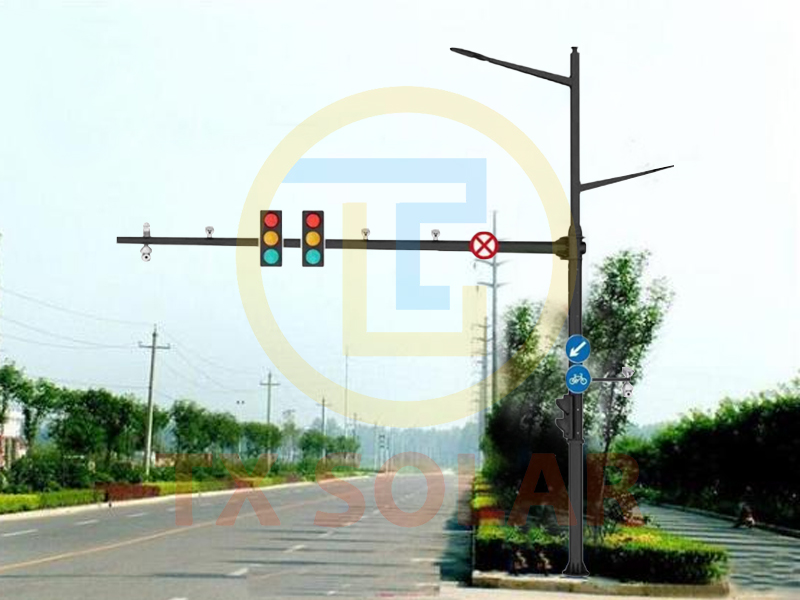Traffic signal poles are an important part of road infrastructure, providing guidance and safety to drivers and pedestrians. Among various types of traffic signal poles, the octagonal traffic signal pole stands out for its unique shape and visibility. When determining the ideal location for installing an octagonal traffic signal pole, there are several factors to consider to ensure it effectively manages traffic flow and improves road safety.
Visibility and accessibility
One of the main considerations when installing an octagonal traffic signal pole is visibility. Pole should be placed in a location that is easily visible to all road users including drivers, cyclists, and pedestrians. This ensures that traffic signals displayed on the poles are visible, allowing road users to react promptly. Additionally, the pole should be accessible for maintenance so technicians can easily reach and service traffic lights and related equipment.
Intersection control
Octagonal traffic signal poles are often used at intersections to control traffic flow and improve safety. When determining where to install these poles, it is critical to consider the specific needs of the intersection. Light poles should be strategically placed to provide optimal traffic signal visibility to all approaching vehicles. In addition, its placement should take into account the location of other traffic control devices such as stop lines, crosswalks, and signage to ensure comprehensive intersection control.
Pedestrian crossing
In areas with crosswalks, the installation of octagonal traffic signal poles plays a vital role in ensuring pedestrian safety. These poles should be located close to the crosswalk so pedestrians can clearly see the traffic signal and safely navigate the intersection. Placing utility poles at an appropriate distance from intersections can help effectively manage the movement of vehicles and pedestrians, reduce the risk of accidents, and improve overall safety.
Traffic flow management
Efficient traffic flow management is crucial to minimizing congestion and improving the overall functionality of the road network. Octagonal traffic signal poles should be strategically placed to facilitate smooth traffic flow. This includes considering factors such as distance to the preceding intersection, alignment with lane markings, and visibility of signals at different angles of approach. By carefully assessing traffic flow patterns, the installation of these poles can contribute to better traffic management and reduce travel time for road users.
Road geometry and land use
Road layout and surrounding land use also influence the placement of octagonal traffic signal poles. In areas with complex road geometry, such as sharp bends or steep slopes, light poles should be positioned to ensure optimal visibility without impeding the natural flow of the road. In addition, surrounding land use, including buildings, vegetation, and other infrastructure, should be considered to avoid any visual obstructions that may impede the effectiveness of traffic signals.
Security considerations
Safety is paramount when determining where to install an octagonal traffic signal pole. These poles should be placed in areas that do not pose a hazard to road users. This includes ensuring poles are kept away from the edge of the road to minimize the risk of collision and provide a safe buffer zone for vehicles. Additionally, installation should comply with safety standards and regulations to prevent any potential risks to road users and maintenance personnel.
Community opinion and feedback
In some cases, community input and feedback can play an important role in determining the location of the octagonal traffic signal pole. Local residents, businesses, and road users may have valuable insights into traffic patterns, safety issues, and specific areas where installing traffic signal poles would be beneficial. Working with communities and taking their input into account allows for more informed decisions to be made about the placement of these poles, ultimately helping to improve road safety and community satisfaction.
Environmental considerations
Environmental factors should also be considered when determining the installation location of octagonal traffic signal poles. This includes assessing impacts on the surrounding environment, such as wildlife habitats, vegetation, and natural features. Careful placement of poles can help minimize environmental damage while still effectively meeting traffic management and safety needs.
In conclusion
All in all, installing octagonal traffic signal poles plays a vital role in managing traffic flow and improving road safety. Factors such as visibility, intersection control, crosswalks, traffic flow management, roadway geometry, safety considerations, community input, and environmental factors should be carefully considered when determining the ideal location for installing these poles. By taking a comprehensive approach to the placement of octagonal traffic signal poles, transport authorities, and city planners can ensure that these important traffic control devices effectively serve their intended purpose and contribute to the overall safety and efficiency of the road network.
If you are interested in octagonal traffic signal poles, welcome to contact TIANXIANG to get a quote.
Post time: Mar-13-2024

